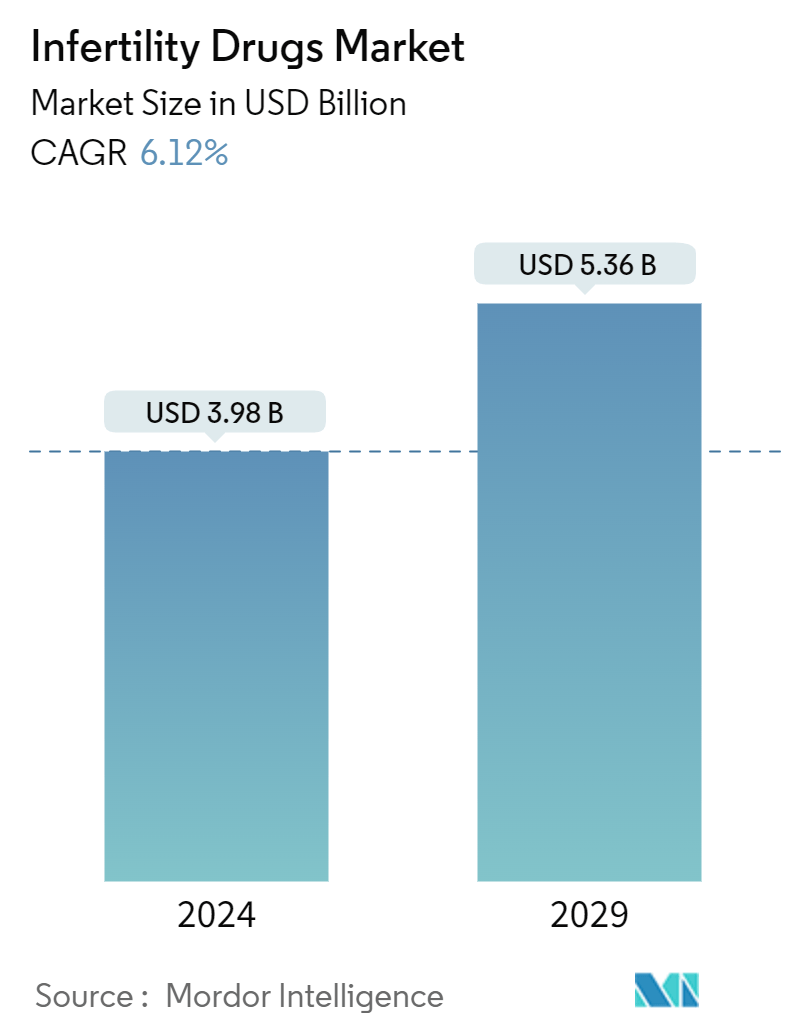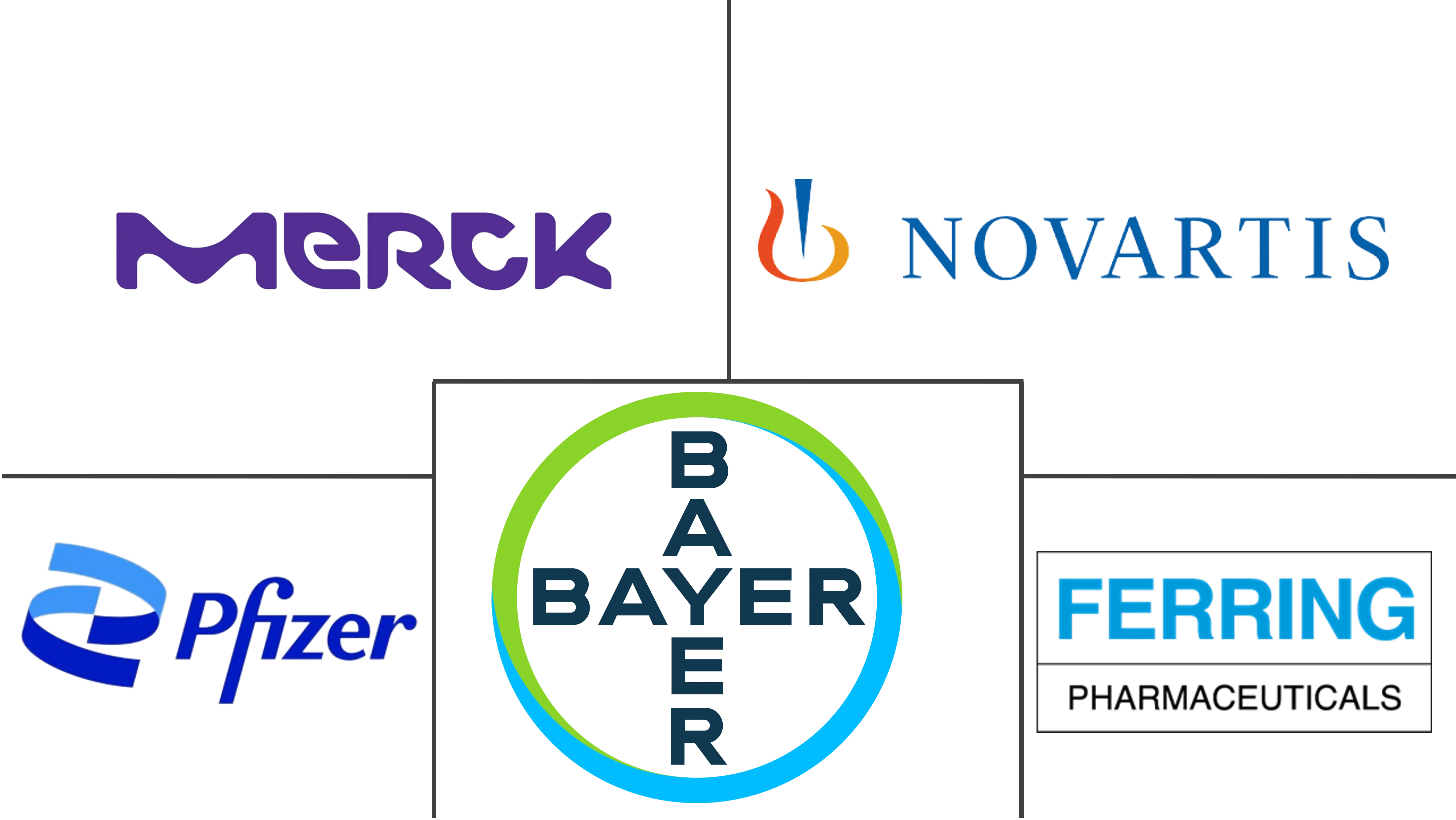Market Size of Infertility Drugs Industry

| Study Period | 2019 - 2029 |
| Market Size (2024) | USD 3.98 Billion |
| Market Size (2029) | USD 5.36 Billion |
| CAGR (2024 - 2029) | 6.12 % |
| Fastest Growing Market | Asia Pacific |
| Largest Market | North America |
| Market Concentration | Medium |
Major Players
*Disclaimer: Major Players sorted in no particular order |
Infertility Drugs Market Analysis
The Infertility Drugs Market size is estimated at USD 3.98 billion in 2024, and is expected to reach USD 5.36 billion by 2029, at a CAGR of 6.12% during the forecast period (2024-2029).
Factors such as the increasing global prevalence of stress and lifestyle-related disorders among men and women, the rise in healthcare awareness, and the increasingly aging female population are expected to boost the Infertility Treatment Market growth.
Infertility continues to pose a global health challenge owing to demographic shifts and continuous lifestyle problems, including obesity, anxiety, and stress, that cause delayed childbearing. For instance, according to the data published by Alcoholic Beverage Consumption Statistics in February 2023, about 63% of adults in the United States aged 18 years or older drank alcohol in 2022, impacting Infertility Rates by Country. Furthermore, according to the data published by the Australian Institutes of Health and Welfare in February 2024, about 6.6 million people consumed alcohol at risky levels during 2022-2023, the same as the number of people in the previous year. Thus, high consumption of alcohol leads to an increase in infertility rates among individuals, which is expected to boost the Infertility Drugs Market growth over the forecast period.
As per the data published in Alcohol Consumption Statistics United Kingdom in February 2023, 12.5% of adults in the United Kingdom reported being teetotal, compared to the country's adult alcohol consumption rate of 71.2% who drank at least once a week. Thus, the high consumption of alcohol affects fertility in males and females. This, in turn, is anticipated to fuel the demand for infertility drugs, thereby propelling the Infertility Therapies Market over the forecast period.
The prevalence of poor fertility among the population is also the key factor driving Infertility Market growth. For instance, according to an article published by the National Library of Medicine in July 2022, about 15% of American couples and at least 180 million other people worldwide were diagnosed with infertility. It is estimated that 9% of Australian men and 8% to 12% of Eastern European men experience infertility issues. Thus, the high prevalence of infertility among the male population is expected to increase the demand for effective drugs, thereby propelling the Infertility Solutions Market.
Furthermore, governments and organizations are increasingly focusing on launching various campaigns to raise awareness regarding fertility care and treatment. For instance, in July 2022, Oasis Fertility launched the Infertility Knows No Gender campaign to commemorate World IVF Day. IVF offers a ray of hope to millions of couples struggling with infertility. In April 2022, Walgreens launched a fertility awareness campaign in support of National Infertility Awareness Week. Such initiatives are anticipated to raise the demand for IVF treatment, fueling Fertility Treatments Market growth over the forecast period.
Therefore, the market studied is expected to grow over the forecast period due to the factors above, such as the high prevalence of poor fertility, increasing sedentary lifestyle, and a growing number of awareness campaigns. However, the stringent regulatory framework for drug approval is expected to impede the growth of the Infertility Drugs Market over the forecast period.
Infertility Drugs Industry Segmentation
As per the scope of the report, infertility is the inability of a woman to become pregnant after one year (or longer) of unprotected sex. The fertility rate decreases with age 35 or above in both men and women. Medicines that regulate or stimulate ovulation are known as fertility drugs. Fertility drugs are the main treatment for infertile women due to ovulation disorders. Fertility drugs generally work with natural hormones, such as follicle-stimulating hormone (FSH) and luteinizing hormone (LH), to trigger ovulation.
The infertility drugs market is segmented by drug class, end user, distribution channel, and geography. By drug class, the market is segmented as gonadotrophins, aromatase inhibitors, selective estrogen receptor modulators (SERMs), biguanides, and other drug classes. By end user, the market is segmented as male and female. By distribution channel, the market is segmented as hospital pharmacies, retail pharmacies, and other distribution channels. By geography, the market is segmented as North America, Europe, Asia-Pacific, Middle East and Africa, and South America. The report also covers the estimated market sizes and trends for 17 countries across major regions globally. The report offers the value (USD) for the above segments.
| By Drug Class | |
| Gonadotrophins | |
| Aromatase Inhibitors | |
| Selective Estrogen Receptor Modulators (SERMs) | |
| Biguanides | |
| Other Drug Classes |
| By End User | |
| Male | |
| Female |
| By Distribution Channel | |
| Hospital Pharmacies | |
| Retail Pharmacies | |
| Other Distribution Channels |
| By Geography | ||||||||
| ||||||||
| ||||||||
| ||||||||
| ||||||||
|
Infertility Drugs Market Size Summary
The infertility drugs market is poised for growth, driven by a combination of factors including the increasing prevalence of infertility, lifestyle-related disorders, and an aging population. The market experienced setbacks during the COVID-19 pandemic due to supply chain disruptions and the temporary suspension of fertility treatments, which led to a decline in demand. However, as restrictions eased and fertility services resumed, the market saw a resurgence in demand. The rising awareness of healthcare and the impact of lifestyle choices, such as alcohol consumption, on fertility are expected to further propel market growth. Government and organizational initiatives aimed at raising awareness about fertility issues and treatments are also contributing to the market's expansion.
The gonadotrophin segment is anticipated to witness significant growth due to its high efficacy in treating infertility and the introduction of new products. The increasing number of research studies and clinical trials supporting the effectiveness of gonadotropin drugs is expected to boost their adoption. North America is projected to hold a substantial market share, driven by the rising incidence of infertility and related health issues, as well as increased demand for advanced infertility treatments. The market is moderately competitive, with key players like Ferring Pharmaceuticals, Pfizer, and Merck KGaA actively participating. Recent developments, such as the production of recombinant hormones in Russia and FDA approvals for new drugs, indicate ongoing innovation and expansion within the market.
Infertility Drugs Market Size - Table of Contents
-
1. MARKET DYNAMICS
-
1.1 Market Overview
-
1.2 Market Drivers
-
1.2.1 Increasing Global Prevalence of Stress and Lifestyle Disorders among Men and Women
-
1.2.2 Rise in Healthcare Awareness along with Increasing Aging Female Population
-
-
1.3 Market Restraints
-
1.3.1 Stringent Regulatory Framework that Delays the Approval of Products
-
-
1.4 Porter's Five Forces Analysis
-
1.4.1 Bargaining Power of Suppliers
-
1.4.2 Bargaining Power of Buyers/Consumers
-
1.4.3 Threat of New Entrants
-
1.4.4 Threat of Substitute Products
-
1.4.5 Intensity of Competitive Rivalry
-
-
-
2. MARKET SEGMENTATION (Market Size by Value - USD)
-
2.1 By Drug Class
-
2.1.1 Gonadotrophins
-
2.1.2 Aromatase Inhibitors
-
2.1.3 Selective Estrogen Receptor Modulators (SERMs)
-
2.1.4 Biguanides
-
2.1.5 Other Drug Classes
-
-
2.2 By End User
-
2.2.1 Male
-
2.2.2 Female
-
-
2.3 By Distribution Channel
-
2.3.1 Hospital Pharmacies
-
2.3.2 Retail Pharmacies
-
2.3.3 Other Distribution Channels
-
-
2.4 By Geography
-
2.4.1 North America
-
2.4.1.1 United States
-
2.4.1.2 Canada
-
2.4.1.3 Mexico
-
-
2.4.2 Europe
-
2.4.2.1 Germany
-
2.4.2.2 United Kingdom
-
2.4.2.3 France
-
2.4.2.4 Italy
-
2.4.2.5 Spain
-
2.4.2.6 Rest of Europe
-
-
2.4.3 Asia-Pacific
-
2.4.3.1 China
-
2.4.3.2 Japan
-
2.4.3.3 India
-
2.4.3.4 Australia
-
2.4.3.5 South Korea
-
2.4.3.6 Rest of Asia-Pacific
-
-
2.4.4 Middle East and Africa
-
2.4.4.1 GCC
-
2.4.4.2 South Africa
-
2.4.4.3 Rest of Middle East and Africa
-
-
2.4.5 South America
-
2.4.5.1 Brazil
-
2.4.5.2 Argentina
-
2.4.5.3 Rest of South America
-
-
-
Infertility Drugs Market Size FAQs
How big is the Infertility Drugs Market?
The Infertility Drugs Market size is expected to reach USD 3.98 billion in 2024 and grow at a CAGR of 6.12% to reach USD 5.36 billion by 2029.
What is the current Infertility Drugs Market size?
In 2024, the Infertility Drugs Market size is expected to reach USD 3.98 billion.

